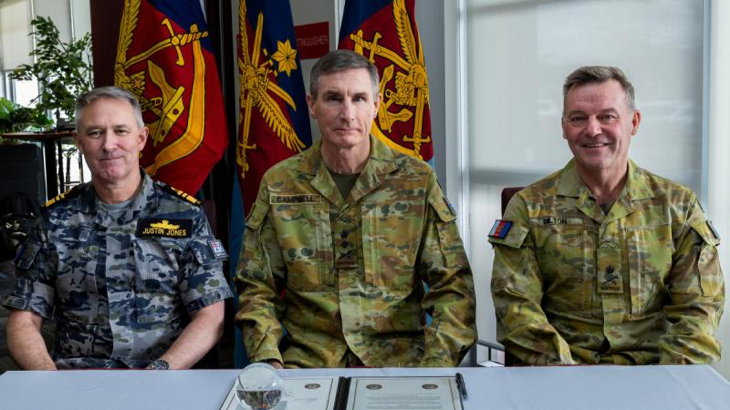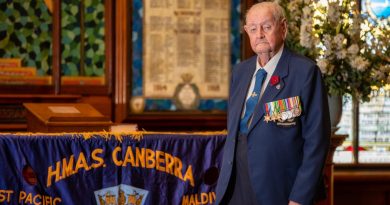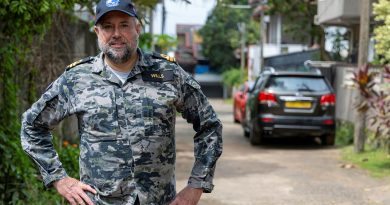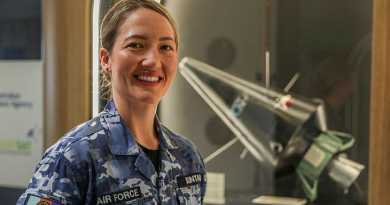Venn diagram that shaped career of a top operator
Share the post "Venn diagram that shaped career of a top operator"

When 16-year-old former Army cadet Greg Bilton walked into the Melbourne recruiting office in 1982, he had no ambition to become a general, and didn’t even think it would be possible.
CAPTION: From left, Vice Admiral Justin Jones, RAN, Chief of the Defence Force General Angus Campbell and Lieutenant General Greg Bilton during the Headquarters Joint Operations Command handover ceremony at General John Baker Complex, Bungendore, on July 5. Story by Corporal Michael Rogers. Photo by Sergeant Sagi Biderman.
Nearly 42 years later, Chief of Joint Operations Lieutenant General Greg Bilton has closed the book on a career that reached one of the most senior command positions in the ADF.
Inspired to join by his grandparent’s service in both world wars, his time as an Army cadet cemented Lieutenant General Bilton’s decision to serve.
He started training at the Royal Military College – Duntroon, a period of personal transition that was challenging and rewarding.
“A lot of the things we did at the college focused on team building and making you more resilient, but most importantly operating as a member of the team,” Lieutenant General Bilton said.
“I really enjoyed both the academics and military training and the way that the course weaved both aspects into each year’s training.”
An influential part of his training proved to be a simple Venn diagram, shown during a leadership lesson at the college, that would affect his way of thinking throughout his many command roles.
“It talked about group needs, individual needs and task needs. It was emphasised in training that task needs are first, then group needs and then your needs will be last, and that always resonated with me,” Lieutenant General Bilton said.
“It’s for others to judge the effectiveness of my command, but that simple diagram very much shaped my career.”
He graduated into the Royal Australian Artillery in 1986, and during his training at the Army Artillery School at North Head, Lieutenant General Bilton met Rachael, his wife of nearly 30 years.
After finishing at the school, he completed postings at 1st and 4th Field Regiments, 8th/12th Medium Regiment and the School of Artillery.
He deployed on Operation Mazurka in 1993, and on Operation Slipper in 2008 as Deputy Chief of Staff for Security Sector Reform on Headquarters Regional Command South, Afghanistan.
Lieutenant General Bilton held command positions at all levels, which he believes is the greatest opportunity in Defence.
“To command at battery, regimental and brigade level, then here at JOC and also holding deputy roles in between as well, those jobs are what I frankly joined the military to do,” Lieutenant General Bilton said.
“I don’t think I fully comprehended that, [when] going to the Royal Military College, but they’re the jobs that have been the most challenging and rewarding.”
His most memorable posting was as Commander 7th Brigade from 2012-14, a time when the brigade was on a high operational tempo.
However, it was also a trying time, with the deaths of three 7th Brigade soldiers on operations in August of 2012.
Seeing first-hand the devastating impact it had on the families and soldiers of the brigade was challenging.
“I couldn’t fully understand their circumstances, but as a leader, you have to navigate that and help where you can and try and lighten the burden of grief,” he said.
Lieutenant General Bilton is looking forward to keeping in touch with the military through mentoring and charitable roles, though he sees his retirement more as a shift into the next phase of his career.
“It’s been a long career in the Army, characterised by a focus on operations and capability development,” he said.
“I’d like to think that in 41-and-a-half years I’ve contributed to modernising the Army and enhancing the ADF’s operational capability and the ability to fight.
“I can see evidence of that, but it’s probably for others to judge the extent to which I’ve had that impact.”
Lieutenant General Bilton concludes his career as the longest-serving Chief of Joint Operations, handing over the weight of command to Vice Admiral Justin Jones RAN at Headquarters Joint Operations Command in Bungendore on July 5.
Vice Admiral Jones will be the seventh Chief of Joint Operations, responsible for the planning, control and conduct of all Australia’s military campaigns, operations, joint exercises and other activities in order to meet Australia’s national objectives.
.
.

.
.
Share the post "Venn diagram that shaped career of a top operator"





